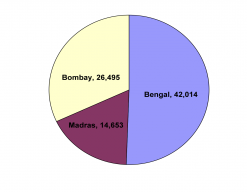Copper Markets
The industrialisation of Welsh copper relied on demand from overseas for its growth. Indian markets, the Transatlantic Slave Trade and the British Navy were amongst the biggest customers.
Mass production and mass markets
 Many new ways of manufacturing copper products developed in Birmingham from the 1770s. Small objects such as brass buckles, buttons, ornaments and toys, and new household items such as saucepans, kettles and silver-plated cutlery, became affordable for many more people by 1800. Steam engineering also required large quantities of brass for fittings such as bearings and valves.
Many new ways of manufacturing copper products developed in Birmingham from the 1770s. Small objects such as brass buckles, buttons, ornaments and toys, and new household items such as saucepans, kettles and silver-plated cutlery, became affordable for many more people by 1800. Steam engineering also required large quantities of brass for fittings such as bearings and valves.
Birmingham manufacturers such as Matthew Boulton established the Birmingham and Rose, or Ynys, works in Swansea in 1793 purely to feed this demand. By the early nineteenth century a shortage of coins opened another market. Boulton’s Soho Mint produced more coins and tokens than London’s Royal Mint, for British and foreign markets.
 Another early commercial demand for copper came from the Atlantic slave trade. Copper and brass rods, vessels and manillas were used to purchase enslaved West Africans.
Another early commercial demand for copper came from the Atlantic slave trade. Copper and brass rods, vessels and manillas were used to purchase enslaved West Africans.
Thomas Coster of Bristol established the White Rock works in Swansea in 1737 partially to profit from this. West Indian sugar - grown, processed and distilled by slaves - was also a major consumer of Welsh copper.
Wales and the East
The first international markets for Welsh copper emerged in South Asia in the 1730s. The British East India Company oversaw this trade. By the 1760s Britain overtook Japan as South Asia’s main copper supplier.
Eastern demand stimulated the growth of many Welsh copper companies. London merchant Richard Lockwood and Swansea entrepreneur Robert Morris formed Lockwood, Morris and Co. at the Llangyfelach works in 1727. The East India Company was one of their most important customers, purchasing copper and brass plates until the 1790s. ‘Japanned’ copper, with a dark glossy lacquered finish, was in particular demand.
In the 1780s the Mackworth and Gnoll Copper Company of Neath supplied copper bottoms for salt boilers, pitch kettles, copper linings for stationery cases, plates for mill bedstones, copper nails, and copper for brass ordnance.
The trade with Asia continued on a greater scale in the nineteenth century and lasted until the mid-twentieth century. From 1869 the opening of the Suez Canal enabled copper to be shipped to the continent much more rapidly.
Copper-bottomed victories
 The biggest domestic consumers of Welsh copper in the later eighteenth century were the British naval and merchant fleets. War and growing world trade took ships regularly through tropical waters where ship worms caused considerable damage to wooden hulls. In 1761 the Royal Navy began using copper sheets to sheath and protect their ships.
The biggest domestic consumers of Welsh copper in the later eighteenth century were the British naval and merchant fleets. War and growing world trade took ships regularly through tropical waters where ship worms caused considerable damage to wooden hulls. In 1761 the Royal Navy began using copper sheets to sheath and protect their ships.
Copper sheathing also prevented barnacles from attaching to hulls, allowing the vessels to travel faster and with more manoeuvrability. The French and other navies soon followed suit, although the smooth-rolled sheets on British ships were considered to be superior. By the early 1780s however copper sheathing was almost abandoned. It reacted badly with its iron fastenings, causing the sheets to come away from the hull. The solution came in 1783 when cold-rolled hardened copper bolts were developed. A key supplier was Thomas Williams’s Parys Mine Company.
By the early 1780s however copper sheathing was almost abandoned. It reacted badly with its iron fastenings, causing the sheets to come away from the hull. The solution came in 1783 when cold-rolled hardened copper bolts were developed. A key supplier was Thomas Williams’s Parys Mine Company.
In 1832 a cheaper alternative to copper was ‘yellow metal’. This copper alloy was patented by George Frederick Muntz of Birmingham and manufactured in several of the south Wales works.

Swansea and Neath suppliers of copper to the East India Company, 1750-1800
Lockwood, Morris & Co. (Fforest Works), 1750-1793.
Joseph Percival & Co. (White Rock Works), 1750-1763.
John Freeman & Co. (White Rock Works), 1763-1800.
Chauncey Townsend & Co. (Upper Bank Works), 1756-1765.
George Pengree & Co. (Middle Bank Works), 1765-1785.
Thomas Williams and the Parys Mine Co.(Upper Bank Works), 1782-1800.
Fenton & Co. (Rose Works), 1777-1786.
The Mines Royal Company (Neath Abbey), 1755-1797.
Sir Herbert Mackworth & Gnoll Copper Company (Neath), 1776-1791.
(Compiled by Huw Bowen)
Download Mass Production and Mass Markets / Dadlwytho Masgynhyrchu a Masfarchnadoedd (PDF, 807KB)
Download Wales and the East / Dadlwytho Cymru a’r Dwyrain (PDF, 758KB)
Download Copper-Bottomed Victories / Dadlwytho Llongau Buddugoliaethus (PDF, 791KB)
